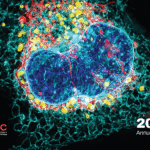Heat-Activated Imaging: New NIR-II Material Glows for a Longer Lifetime
03 Jun, 2025
Recent News
- A Century Ago Quantum Mechanics Reshaped Physics. Today, it’s Revolutionising Medicine – One Diamond at a Time
- Crystals, Colour Centres, and the Brain: Quantum Sensing Using Lab-grown Diamonds
- Tiny Thermometers, Big Impact: Meet Farrel Separgo’s Vision for Future Diagnostics
Seeing deep into the brain without harming delicate tissue is one of the biggest challenges in medical imaging. Researchers from QUBIC at the University of Technology Sydney have developed a new material that could help, one that glows longer and more stably as temperatures rise.
Published in Nano Letters, the material emits long-lasting near-infrared (NIR-II) light, which is ideal for deep-tissue imaging. Unlike traditional materials that fade when they heat up, this one becomes more luminous, making it easier to see what’s happening inside the body, potentially useful during surgery or in areas where temperature changes are common.
This research supports QUBIC’s mission to develop quantum-enabled technologies that reveal the inner workings of living systems. The material leverages the quantum properties of lanthanide ions, pairing special energy levels of different ions to enable more efficient energy transfer at higher temperatures. This design turns thermal fading, a long-standing problem, into an advantage, allowing for clearer, more stable imaging when it’s needed most.
By advancing the fundamental understanding of energy transfer in lanthanide systems, this work contributes to the development of next-generation imaging materials that could support neurological research, where non-invasive, high-resolution access to brain structures is critically needed.
Published paper: Thermally Prolonged NIR-II Luminescence Lifetimes by Cross-Relaxation (2024)
 This impact story is an extract from QUBIC’s 2024 Annual Report: read more.
This impact story is an extract from QUBIC’s 2024 Annual Report: read more.